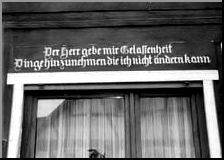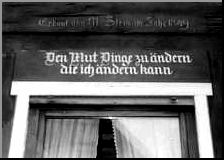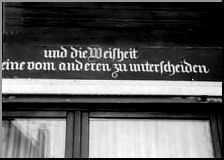Research and Reflection


The Serenity Prayer
The source of the Serenity Prayer in all its various incarnations has been
the subject of much discussion. A simple search of the internet and
published works will present numerous arguments for Reinhold Niebuhr being the
author, most being simple restatements or direct copies of other research.
Many of these sources refer to authorship by Friedrich Oetinger as “mythical.”
The following article by Dr.
John E. Sasser discloses some evidence that the prayer predates Niebuhr's
version
by at least 11 years - and is likely much older.
Dr. John E. Sasser is a mathematician, educator, linguist and author who has
traveled, studied and worked in over 75 countries around the world. He holds graduate
degrees in mathematics, education and theology. His credentials are too
extensive to list in this introduction.
http://www2.eos.net/jsasser/
The article below is Copyright 1985; 1992; 2007 by
John E. Sasser, Ph.D.
Used here with the permission of
Dr. Sasser. All other rights reserved.
Any reproduction, or other use of this material is prohibited
without the written approval of the author or his agent.
| F.C. OETINGER AND THE SERENITY PRAYER John Sasser, Ph.D. Cincinnati, Ohio | ||
| An article appeared in the January 1950 issue of The Grapevine entitled," The Serenity Prayer ... it’s origin is traced...” . The article began: “At long last the mystery of the Serenity Prayer has been solved!“ It supports Reinhold Niebuhr’s claim to authorship. While it is not certain that FRIEDRICH CHRISTOPH OETINGER (1702-82) wrote the prayer, it is certain that Reinhold Niebuhr did not write the prayer! Here are photographs I took in the mid-1980's in Bergen-Enkheim, Germany. The ("Gasthaus") was built in 1849. The words of the serenity prayer are above the windows of the first floor. | ||
 |
 |
 |
| God give me the serenity to accept the things I cannot change | the courage to change the things I can | and the wisdom to know the difference |
|
|
||
| "Built by M. Stein in the year 1849" | ||
| (barely discernable above the middle window's script) | ||
|
** Any questions about authenticity or manipulation of these images may be answered by going to this page:
http://ourspecial.net/misc/oet_image_orig.htm |
||
| While I could not find out when the prayer was initially written on this building, a life-time resident, Frau Mankel Dworschak, #39 Markstrasse, told me she remembers seeing the prayer between 1920 and 1930. Frau Dworschak was born in 1911 and said she memorized the prayer when she was eleven years old. The name of the building at that time was “Gaststaette Tiger.” Reinhold Niebuhr claims to have written the prayer in 1934 while professor at Union Theological Seminary in New York City. Friedrich Christoph Oetinger (1702-82) was born in Goppingen, Germany. He was educated at Tuebingen University, one of the great theological schools of the world. He worked as a private tutor there from 1731 until 1738. In 1738 he became pastor at Hirsau; in 1743 at Schnaitheim; in 1746 at Walddorf. In 1752 he became Dean of the a school in Weinsbert and in 1759 in Herrenberg. He became Prelate at Murrhardt in 1766. F.C. Oetinger was a German Lutheran mystic, Pietist, al-chemist and theosophist. His theology of the end-time expectation generated definite social and political demands--for example, the dissolution of the state, abolition of property, and elimination of class differences. Reinhold Niebuhr was born in 1892 in Wright City, Mo. Niebuhr was the son of Gustav and Lydia Niebuhr, who had emigrated from Germany to the United States. Gustav Niebuhr was a minister of the Evangelical Synod of North America, a denomination with a Lutheran and Reformed German background that merged into the Evangelical and Reformed Church in 1934 and is now a part of the United Church of Christ. At an early age Reinhold Niebuhr decided to emulate his father and become a minister. He graduated from his denomination's Elmhurst College, Illinois (1910), and Eden Theological Seminary, St. Louis, Mo. (1913), and completed his theological education at Yale University, receiving a bachelor of divinity degree (1914) and a master of arts (1915). He was ordained to the ministry of the Evangelical Synod in 1915. Since Oetinger and Reinhold Niebuhr’s father were both Lutheran pastors from Germany, Reinhold’s father was no doubt familiar with the Serenity Prayer, written by F.C. Oetinger who died one hundred and ten years before Reinhold was born. It is probable that Reinhold first heard this prayer in the original German from the lips of his father: Gott gebe mir die Gelassenheit, Dinge hinzunehmen, die ich nicht aendern kann, den Mut, Dinge zu aendern, die ich aendern kann, und die Weisheit, das eine vom anderen zu unterscheiden. Christof Friedrich Oetinger (1702-1782) Niebuhr composed a prayer in 1934, for a worship in a small summer church near his summer home in Heath, Mass. The prayer is as follows: “God, grant me the serenity to accept the things I cannot change: Courage to change the things I can; And wisdom to know the difference. May I be content to live one day at a time. Permit me to accept the hardships as the pathway to peace. Taking as Christ did this sinful world as it is, not as I would have it. Grant me the faith that He will make all things right if I surrender to His will so that I may be reasonably happy in this life and supremely happy with Him in the next. Amen.” Dr. Niebuhr is quoted in the January, 1950 Grapevine as saying the prayer “might have been spooking about for years, perhaps centuries.” Certainly, Dr. Niebuhr wrote all the above prayer except the first four lines and he no doubt was the first to have translated the first four lines into the English language. We are indebted to Dr. Niebuhr for this contribution. Furthermore, Dr. Niebuhr might not have been conscious of hearing the prayer in German as a boy from his father and honestly believed he authored the first four lines himself. A neighbor, Dr. Howard Robbins, who was chairman of the worship committee of the Federal Council of Churches asked whether he could use the prayer in his monthly report. Niebuhr handed him the original, “here, take the prayer, I have no further use for it.” The first four lines of the prayer were lifted by the Federal Council and printed for the soldiers in World War II. The U.S.O. distributed millions of copies during World War II. The prayer came to Alcoholics Anonymous by the way of an obituary notice from a New York paper. Underneath a routine account of the one who had died there appeared the words of the Serenity Prayer. Ruth Hock, secretary to the co-founder of A.A., Bill Wilson, was admiring the prayer when a friend walked into the office. He exclaimed, “We ought to print this on cards and drop one into every piece of mail that goes out of here. I’ll pay for the first printing.” With this beginning the Serenity Prayer came into general use and took its place alongside the Lord’s Prayer and the Prayer of St. Francis among the members of the fellowship. The prayer first appeared in the Grapevine, an official publication of A.A., in September, 1948, and has been part of the magazine ever since. An article in the November, 1964 Grapevine related an attempt to trace the prayer to Koblenz, West Germany, where a tablet inscribed with the prayer was discovered. It was attributed to F.C. Oetinger. This article was translated into German and appeared in "Irgendwo AA", a west German AA periodical, in October, 1965. A search for the tablet, by Inge of Bochum, Germany, lead to the hotel in Koblenz, which was by that time a military service center. They found a book entitled, “School of the Army for Internal Guidance” and in it was a photo of the very tablet, but it was not in the converted hotel on the Rhine, but in the school headquarters at Paffendorf. In Paffendorf, in the entrance hall of a modern building on top of a hill, was the tablet surrounded by flags. There was the tablet with the serenity prayer, but the inscription “Friedrich Oetinger, 1702-1782” could not be verified. The school’s press officer told Inge ‘“the prayer is the motto of all U.S. soldiers since it hangs in the Pentagon.” A.A. could find no official prayer-motto of the U.S. armed forces at all, although here and there in the Pentagon it hangs framed on an office wall. Perhaps the United States Armed Forces should make the Serenity Prayer its official prayer since, as Inge suggested, it is indeed appropriate for those who fight -- to include those who fight the bottle. AND THE WISDOM TO KNOW THE DIFFERENCE (Christof Oetinger, 1702-1782) ©1985; 1992; 2007 John E. Sasser, Ph.D. Used here with the permission of Dr. Sasser. All other rights reserved. Any reproduction, or other use of this material is prohibited without the written approval of the author or his agent. | ||
|
|
||
|
Comments:
Elizabeth Sifton, the daughter of Reinhold Niebuhr, in her book Prayer,
Faith and Politics in Times of Peace and War, attributes the “Oetinger
Myth” to a professor at the University of Kiel named Theodor Wilhelm. Wilhelm
apparently claimed authorship of the the “Serenity Prayer” in a book published
in 1951 under the pseudonym “Friedrich Oetinger”.
Well, perhaps. Maybe he did. But in the middle 1980’s Dr. Sasser found at least
1 resident who had memorized a German version as early as 1922, ...and he
provides photos of a version scribed on a building built in 1849.
Fredrich Christoph Oetinger spent virtually his whole life and ministry, in the 1700's, within a 35-40 mile radius East, South and West of Stuttgart, Germany.
The Gustav Reinhold offspring became 'world personages' in the 20th Century- Reinhold Niebuhr's younger brother, Richard becoming prominent as a
theologian at Yale University, where Reinhold also studied. Reinhold's
daughter, Elizabeth Sifton, also went on to prominence, while his grandson,
Gustav, became a noted journalist and religious commentator.
Other than the Sifton statement above,
I have found little thus far concerning "Theodor Wilhelm".
back to top
|
||
|
OSN anti-spam powered by
Our Special Net Gean-ealogy.com Chatham History 26thNC OSN Images The CHIPS Group Odes OSN Weather OSN Search About Our Special Net |
||